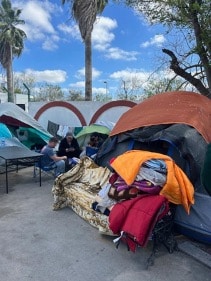Note: This is the second article in a three-part series involving my visit to the southwest border of the U.S. in February 2024.
During the week of February 19, 2024, I toured the southwest border of the U.S. in the area around McAllen, Texas. After the tour, I set out to explore the conditions on both sides of the border on my own. I had security protocols in place and wanted to see more of the area outside of McAllen.
Nuevo Progreso and Medical Tourism
On the Mexican side of the border, the first place I visited was a town called Nuevo Progreso (“New Progress”). As I walked over the bridge into Mexico, I was inundated with people trying to sell me their products.
The main street of Nuevo Progreso is filled with tourist shops, medical clinics and dental clinics. There were a lot of vendors selling prescription drugs such as alprazolam (Xanax), oxycodone and Percocet.
Many people held up cardboard signs with empty prescription boxes, advertising what they were selling. I asked one of the vendors how Americans purchase these prescription drugs and take them back to the U.S. The vendor told me that the drugs come with a prescription that I could use to take the drugs back to the U.S.
According to Valley Central, Mexico ranks number four in the world for medical tourism, but purchasing prescription medications in Mexico can be dangerous. There have been cases where Mexican pharmacies have sold drugs that appear to be legitimate pharmaceutical products, but the LA Times points out that those drugs contain fentanyl and methamphetamine.
Speaking with Migrants in Nuevo Progreso after My Tour of the Southwest Border
On the Mexican side of the bridge at Nueva Progreso, I observed hundreds of migrants who had come from Russia and countries from Eastern Europe. They were living on the town’s sidewalks, sleeping in tents and sleeping bags.
These migrants are awaiting an immigration appointment in the United States. Some may wait for a month or more before their appointment.
I spoke with a group who came from Russia. They had flown into Mexico City and were smuggled to Nuevo Progreso.

There were some migrants from Central and South America located in this tent city, but they were too terrified of the cartels to speak to me. By contrast with the migrants from Central and South America, the Russians had suffered less exposure to violence and danger.
The Border in Roma, Texas Is Unsecured by a Barrier
My next stop was Roma, Texas. I stopped at several locations along the Rio Grande river near this city.
Near dusk, I saw a group on the riverbank. They may have been waiting for nightfall to cross the river.
It would be very easy for someone being smuggled to the United States to cross the river and walk into Roma from Mexico. I did not see a barrier in any location I visited along the Rio Grande in Roma, but I did observe tire marks – possibly from a cartel vehicle – in a shallow part of the Rio Grande.

Going to Piedras Negras, Mexico
My next stop was Eagle Pass, Texas. Shelby Park, an area in this town, was completely barricaded and did not have much migrant activity at the time when I was there. It was guarded by Texas National Guard and state law enforcement.
I later went to Piedras Negras (“Black Stones”), Mexico. Unlike Nuevo Progreso, I did not see other Americans or migrants.
There was a noticeable tension among the residents of Piedras Negras. Although the town was calm and peaceful during my visit, Piedras Negras and other communities in the rest of the region have seen extreme cartel violence in the past.
In the past, the Zeta Cartel had a reign of terror over area residents. This cartel was responsible for devastating Allende, a quiet farming community located south of Piedras Negras.
Over a three-day period, the Zetas kidnapped, murdered and burned the bodies of as many as 300 victims. Local residents believe that this incident was a result of revenge for someone who became a Drug Enforcement Agency (DEA) informant and provided cellphone intelligence involving some cartel bosses, notes The Straits Times.
According to law enforcement officers and residents on both sides of the border, the border towns on the Mexican side are typically calm. But when authorities make a high-profile arrest involving a cartel boss, the communities brace for violence. Some border areas have also seen extreme violence as feuding cartels fight over territory.
When violence occurs in these Mexican border towns, residents hide from cartel members by sheltering in their homes. Cartel members commonly use high-caliber weapons that are equivalent to or an even higher caliber than the guns used by Mexican law enforcement and military services.
Related: Organized Crime Groups: The Battle to Stop Their Activities
Other Observations from My Trip to the Southwest Border
My trip between Nueva Progreso and Eagle Pass involved 250 miles. I noticed that Border Patrol and the Texas National Guard had a significant presence around the southwest border. Some areas had the border wall, and some areas did not.
I traveled through several Border Patrol checkpoints. As I approached one checkpoint, I noticed that the vehicles ahead of me were being stopped by officials. One driver came to an abrupt stop and made a U-turn to avoid the Border Patrol checkpoint, which was a poignant reminder of the smuggling and human trafficking activity in this area.
In my final article, I will discuss what can be done to solve the humanitarian crisis in this area of the country.

Comments are closed.